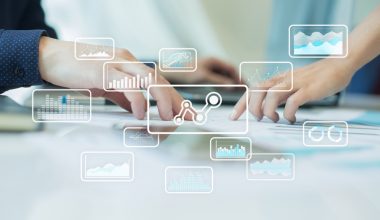Artificial intelligence and machine learning revolutionize our industry – especially for complex and high-data operations, such as stock trading.
Since the first stock price ticker system was introduced in Calahan in the 1860s, machines became an important component of the worldwide stock market. Now, computers are so integrated into the trading process that 80% of the stock market is on autopilot, mainly because of the increase in passive funds and investments.
Advances in machine learning and artificial intelligence (AI) are now opening up new methods to incorporate technology into the business process and may help democratize the stock market and alleviate certain automated trading issues.
AI enables us to get brand feedback in real-time; reduces the chance of mistakes and automates most of our everyday operations; it enhances the cellphones we take; evaluates our creditworthiness, etc.
Forex trading is one of the markets that most benefits from artificial intelligence and machine learning. Forex is the ever-growing $1.93-quadrillion industry. Recent research indicates $5.3 trillion is exchanged every day in this market. Low costs, great liquidity, easy entrance, a wide range of trading couples, and no central regulator make traders very appealing. To get the most out of your Forex investments, you still need to grasp the market’s drawbacks. Complex pricing, high volatility, and significant hazards are just a few of them.
AI and Forex Trading
One of the main advantages of AI is machine learning and predictive analysis. Predictive analytics utilizes current commercial data and algorithms to anticipate changes in the market. The capacities of predictive analytics extend to people since they can evaluate large quantities of data more rapidly and make fewer errors. By using AI software to provide predictions, according to this page, traders may concentrate more on the development of intelligent trading methods based on data. Nikkei, a Japanese company, is a great illustration of the usefulness of forex analysis. They created a quarterly Dollar-Yen derby, using artificial intelligence for the following month to forecast exchange rates. The AI program has utilized a broad range of data from several sites, including publications, industry trends, market changes, commodities prices, etc.
They contrasted its findings with the forecasts of their best analysts to evaluate the efficacy of predictive analysis.
Forex traders utilize various devices and platforms for their research, data collection, and trade strategy. The same statistics stress that 35% of forex traders use their cell phones to find and compare FX brokers. In the next several years, mobile trade is projected to increase from 18 to 37 percent.
Due to this amazing fact, the number of FX brokers hopping on the mobile trading car is not unexpected at all. To face the appropriate audiences, forex brokers must spend more on mobile marketing.
Above all, tech-savvy dealers need to offer user-centered experiences, including multi-channel onboarding, a responsive mobile application, and easier deposit and removal procedures. This is best demonstrated in the Ever Forex example, which has begun to alter mobile trading experiences.
Many Forex traders frequently say: “If I had so much info in advance, I would decide to trade better and earn more money.”
Sadly, it’s not that easy.
One of the major issues facing traders is not knowing how to gather their data and not knowing which data is important to them. Most importantly, they don’t know how to strategically utilize the data they gather.
Consequently, individuals begin to depend on irrelevant and false information that may damage their trading strategy’s overall efficacy.
This may be helped by real-time data analysis and automated trading options. You can evaluate live pricing in real-time, find out about issues more quickly, and correct them nearly immediately. Machine learning may utilize huge quantities of trading history to analyze trading data in real-time, provide you with greater insights into the market, and help you modify your trading strategy in line with the volatility of the present market.
Take the example of automatic stop-loss orders in the field of forex trading, which have become an essential feature. In other words, a forex trader with its FX and CFD brokers orders their stop-loss to guarantee that their losses are reduced and that they sell their assets at the greatest price. This function may be very useful, if utilized properly, in a highly turbulent forex market.
Artificial Intelligence and Stock Market
Excellent data creates good choices. But it may go too far. Financial firms gather billions of data points – which may offer significant insights but cause a lot of noise combined. This must all be screened and analyzed, which means that there are several hours of effort to get a trading advantage.
Recent developments in AI, especially machine learning, have given traders a solution that makes sense of all this information. Machine learning algorithms can comprehend and interpret large amounts of data. There are many different kinds of algorithms for machine learning, but they can use insights from previous data sets to make better judgments in the future. Simply put: the usage of machine learning algorithms improves.
Let’s look at some real-world instances of machine learning in action to better grasp how this works.
If you had one item to remove from this essay, AI and algorithms are stupid. They are now unable to comprehend whether or not the data that you provide is defective. This implies that you will obtain poor insights if you feed your algorithm with incorrect data. Just look for a good example in the 2016 presidential election.
To get excellent insights, you need the appropriate structured data collection, and above all, you need to understand in a basic manner the question you are asking.
Once you have large data sets, the next step is to add them to the algorithm. A machine-learning algorithm may emulate the effort done by a whole research department. But it accomplishes it at a fraction of the cost much quicker.
Once a model has been constructed, the next step is to make it workable. Only by applying the models to human traders can this be done. But other companies are attempting to take algorithmic trading a step further.
In the next few years, more access to algorithm trading will be crucial to many businesses and investors. It will probably be important for those who wish to remain competitive. It will also assist in guaranteeing that money is utilized as efficiently as possible to improve the overall economy.






